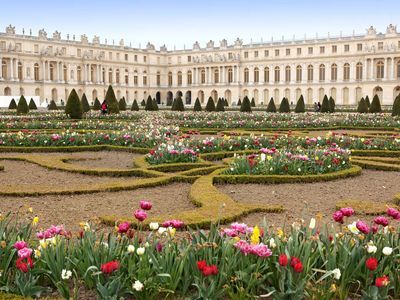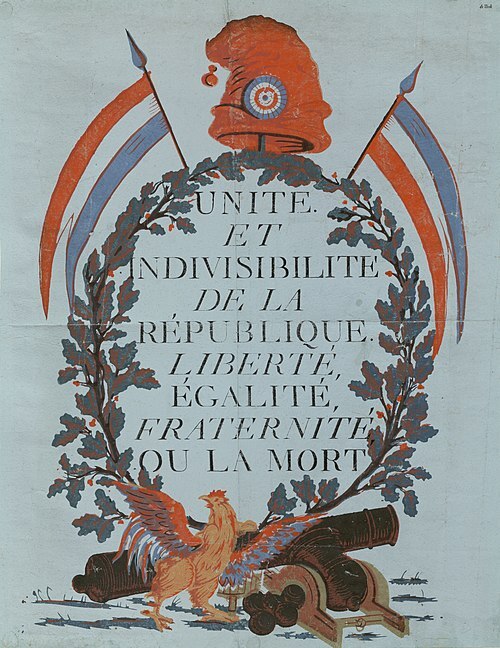Threefold Musings Archive part 2 (Chap 16 on)Chapter 16: Political IdeologyWhere did Left and Right as political descriptors come from? The origin of the left/right political axis is generally dated to 1789,[just before the French Revolution] when the French National Assembly met in Versailles, where the French King, Louis XVI, had his grand Palace.
During this meeting, the legislators who upheld revolutionary values tended to group themselves on the presiding officer’s left, while those who supported the monarchy were grouped on the right. This helped establish a persistent association between the left, "the party of movement" and revolutionary, progressive, liberal values, which tended toward egalitarianism, and between the right, "the party of order" and conservative, traditionalist or hierarchical values. This was binary or 2fold, not 3fold. Even today most Parliaments are binary,consisting of Government (Executive) and Opposition. Motto of the RevolutionDuring the Enlightment of the 18th Century, philosophers like John Locke and Jean-Jacques Rousseau proposed that governments derive their legitimacy from the consent of the governed, creating a social contract between the rulers and the ruled. They challenged the idea of divine right monarchy, advocating for limited government and the separation of powers to prevent tyranny. Out of this, Robespierre (one of the great figures of the French Revolution) suggested that the words "Liberty - Equality - Fraternity" be written on the flags and uniforms of the National Guard in 1790.
The French Declaration of the Rights of Man and of the Citizen explained these terms: Liberty consists of being able to do anything that does not harm others: thus, the exercise of the natural rights of every man or woman has no bounds other than those that guarantee other members of society the enjoyment of these same rights. Equality was defined in terms of judicial equality and merit-based entry to government: The third term, Fraternity, was the most problematic to insert in the triad, as it belonged to another sphere, that of moral obligations rather than rights, harmony [good will] rather than contract, and community rather than individuality. Various interpretations of fraternité existed. One was "fraternité de rébellion" (Brotherhood of the Rebellion), that is the Union of the National Assembly deputies refusing its dissolution as ordered by King Louis XVI: "We swear never to separate ourselves from the National Assembly, and to reassemble wherever circumstances require, until the constitution of the realm is drawn up and fixed upon solid foundations." The French flag, the Tricolore (3 vertical strips of blue, white, and red) was adopted during the French Revolution and is related to the motto:
Rudolf Steiner revived and deepened this motto when he developed his Threefold Social Order.
It is interesting to note how many powerful mottos and phrases in our language have this tripartite form:
Rudolf Steiner used this technique, (called Hendiatris, in which three words are used to express one idea) in his verses, meditations and mantra. In the German language he combined three nouns used in earthly language terms to create one new dynamic word to express a spiritual reality. Some examples from his “Foundation Stone Mediation:
In the English language, words based on Latin or Greek roots often have a triPARTite form of prefix-ROOT-suffix such as monARCHy, bioGRAPHy, unFOLDing and so on..... RB Chapter 17 Recognising 3foldness around us.Many writers and speakers recognise the threefold nature of our society, and also the three related principles of Freedom, Equality and Cooperation in various ways. The particular insight that Rudolf Steiner brings towards threefoldness is the recognition that each of the 3 Realms needs to have one and only one of the principles ruling, and not the others. The principles are mutually incompatible, acting like a poison that causes an illness when applied in the wrong Realm. The healthy connection of principles to Realms, he saw as:
If we look around us, can we see examples of principles being applied in the wrong place causing distractions and thus reducing the effectiveness of what is being done. Here is one example: What happens when we bring Equality into the Cultural Realm, for example, in education. Do we expect everyone to be the same (equal) as a result of their education? Well, let’s make all children sit the same exam and measure them by some external standards. And while you at it, get someone who has never met the child to set the exam! Nothing personal or individual here. On the other hand, what if a teacher gets to know a child, and “reads” by introspection what the child needs by way of experience to develop its faculties and talents, and teacher and child mutually set tasks for the child to achieve? So where does Equality belong? It belongs to the Right of every child to an equal opportunity for a quality education -- which may be expressed by financial support. ***** A key component of the Cultural Realm is the activity of education. The task of education [based on Latin ‘e’ or ‘ex’ = 'out of' or 'forth'; and ‘ducere’ = 'to lead' or 'guide'] is to support, particularly in the first couple decades of life, the incarnation of the human Ego into its bodies [physical, etheric, astral] inherited as a gift from its parents. The incarnation process involves adapting one’s bodies to better suit the spiritual intentions of one’s Ego or Self. The role of teachers is to sympathetically observe their pupils and ‘read’ [with the help of the knowledge of human development derived through spiritual science] their individual evolving situation and create opportunities and activities for the pupils to engage with the world around them – to open the eyes (and indeed all senses) of the pupils to their environment. In this process they engage the pupil's soul processes of thinking, feeling and willing, which leads to them acquiring
So how do exams get into this process? When parents enrol a child in a school, they sign a contract with the school which will specify the rights and obligations of each party. No doubt part of this will be based on a school brochure describing the educational process the school promises. This will presumably include the school’s intention to offer senior students an opportunity in certain classes to test their educational achievement. For this, the school will have contracted with a testing service provider, such as NZQA for NCEA [National Certificate of Educational Achievement], the CAIE [Cambridge Assessment of International Education] or IB [International Baccalaureate]. This, as a service, falls into the Economic Realm. Parents, student and teachers need to be free to assess if sitting such an exam will be educationally beneficial for the student. **** Some goals of Rudolf Steiner’s ‘Art of Education’ are:
The structure of Rudolf Steiner’s education is threefold:
Each stage develops capacities useful in social life
RB ~~~~~ Chapter 18 Rudolf Steiner views on land ownershipRudolf Steiner considered that private land ownership is detrimental and should be replaced by a system where land is held in trust for the community. This concept is a key part of "social threefolding," which considers a radical restructuring of society into independent cultural, political/rights, and economic realms. In Steiner's view, land and the means of production should not be treated as capital to be bought and sold for private gain, but as a shared resource managed for the benefit of all members of society. The problem with private land ownership: Steiner viewed land as being in a category distinct from other economic goods. Land is a finite resource; it is not manufactured. Other than Hong Kong Airport, we cannot make any more of it even if we want more. For most goods, when we have used or consumed what has been made, we can manufacture more as needed. The private ownership of consumer goods, which are meant for immediate use, is entirely appropriate in Steiner's model. This is because their value is tied to their function in satisfying human needs, not to capital accumulation. When land becomes a commodity (that is it can be sold and bought, as it can be now, for exclusive ownership without end), its value is determined by speculation and its potential to generate capital, not by cultural or community needs. This, unfortunately, encourages the concentration of wealth into the hands of a few [oligarchs], which Steiner considered socially destructive. For example, a piece of land might be exploited in a way that generates the highest profit, even if that use is spiritually or culturally harmful to the community. Rudolf Steiner believed that true equality is impossible when Economic interests favouring a few dominate the Rights and Cultural spheres. The solution: Instead of private ownership, Steiner proposed that LAND be held in "common" by self-governing, non-profit community trusts acting as stewards. Under this system, the land would be owned by the community, while the right of access and to use it for a specific purpose (such as farming or housing) by individuals or by corporations for industry, would be determined by the Community Land Trust. The users of the land would pay a regular lease, much like home owners now pay rates to a local body for infrastructure and services such as “3 waters”, and possibly insurance. When a lease expired, the Community Land Trusts would hold hearings to determine who would be the next best person to farm/use a tract of land in terms of value to the community. This would be a democratic process, not dependent on the size of one’s purse but on relevant skills and talents. Farmers and residents would "own" the improvements they make, such as the house on the land, but not the land itself. The departing lessee would sell the improvements to the new lessee. This allows them to benefit from their labour while preventing the speculative capture of land value. In Scandinavian countries municipalities own a moderate proportion of the land. For example, In Oslo more than a third of the city area is ‘publicly owned’. In China, the State owns all urban land. Collectives own land in rural areas (villages). Individuals and entities can acquire land use rights for a fixed period (70 years – about a ‘lifetime’ – in urban areas), but they do not own the land itself. These land use rights can be traded and are subject to the state's power to requisition land for infrastructure or development, making development processes faster than in countries with private land ownership. Māori traditional concepts of land ownership emphasize collective responsibility and belonging to the land, rather than private ownership, with whānau (family) and hapū (sub-tribes) holding rights to specific areas for various purposes. (Many Indigenous cultures are similar.) For Maori land is central to cultural identity and tūrangawaewae (a place to stand). Kaitiakitanga, or guardianship, is the responsibility to protect and care for the land for future generations, which includes respecting the land itself. This contrasts with the European/British (colonisers) concept of individual, absolute ownership, leading to misunderstandings of the 1840 Treaty of Waitangi and later to the NZ Land Wars. ~~~~~ Steiner's views on land ownership need to be seen within the framework of social threefolding, which seeks to differentiate and balance three autonomous spheres of society.
By placing land and productive assets in Community Trusts, the economic sphere is prevented from dominating the other two, leading to a healthier, more balanced society. Aspects of Ownership While private ownership is commonly understood as a single, unified concept, Rudolf Steiner saw it as having different aspects depending on the type of asset. His views fundamentally distinguish between capital (such as land, buildings, infrastructure, machinery, etc.) and goods produced for consumption, which are destroyed and disappear. The nature of capital In Steiner's view, CAPITAL — especially land and the means of production—is a product of the collective efforts of society over generations. It should not be treated as a private commodity for several reasons:
When Rudolf Steiner gave a 8-lecture course on Biodynamic Agriculture in June 1924, in Koberwitz (Poland) he built a holistic picture of a farm as a singular, living entity, akin to a human body, where all parts (soil, plants, animals, humans) work together in a dynamic, integrated system. Each farm is unique, an Individuality with its own specific characteristics and potential, requiring a deep, intimate understanding of its elements—from soil types to local ecosystems—to work in harmony with nature. There is a focus on the interwoven relationships and dependencies between the soil, plants, animals, and the people working the land. Land, including farmland, is prohibitively expensive for young farmers, who have the energy for it. They saddled with debt mortgage for most of their lives. Is there a better system? Demeter International and national associations support Biodynamic farming. Several countries [UK, Germany, France, Switzerland, USA, Canadian provinces, Egypt, New Zealand] have established Trusts owning a farm or farms for Biodynamic farming. It is small, but a beginning. RB ~~~~~
Posted: Sun 27 Jul 2025 |
| © Copyright 2025 Anthroposophy in Hawkes Bay | Site map | Website World - Website Builder NZ |




